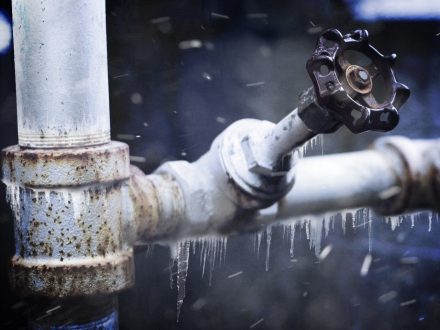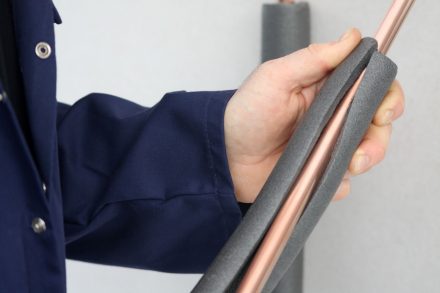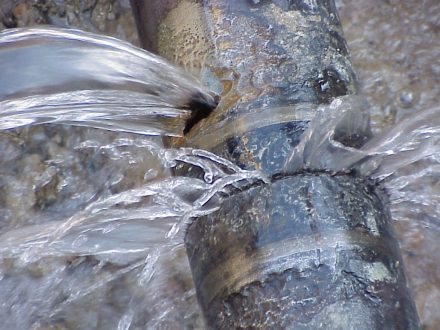
Frozen pipes in a home themselves are a problem, as they prevent water flow, but since water expands as it freezes, this puts incredible pressure on them. This pressure may cause pipes to eventually burst, potentially causing damage, flooding, and can cost thousands of dollars in repair. Luckily, there are ways to prevent your pipes from freezing, saving you both money and hassle.
Quick Facts about Frozen Pipes
Pipes that freeze most frequently are:
- Pipes that are exposed to the cold, like outside water faucets, pool supply lines, and sprinkler lines.
- Water supply pipes in unheated indoor areas such as basements, attics, kitchen cabinets, etc.
- Pipes that run against exterior walls with little to no insulation.
Prepare for cold weather

- It’s always better to be proactive and take preventative action than it is to deal with the aftermath. Before cold weather hits, make sure your home’s pipes are properly insulated for winter temperatures. Pipes that are located in areas that do not have proper insulation, such as basements or attics, may need extra insulation to keep from freezing. Pipe insulation can cost as little as 50 cents per linear foot at your local hardware store
- While you’re inspecting your pipes for insulation, inspect your foundation and walls for cracks. Sealing the cracks will keep cold air out and warm air in, which can protect pipes from freezing. Make sure to keep the fireplace flue damper tightly closed when not in use, and caulk and weather strip doors and windows.
- Disconnect water hoses for the winter. Consider covering the faucets with insulated sleeves which can be found at hardware and home improvement stores.
- Drain water from pool and sprinkler supply lines. Do not put antifreeze in these lines unless directed. Antifreeze is harmful to the environment, and is dangerous to humans, pets, and wildlife.
- For pipes that are easily accessible, electrical heating tape may be an option to keep them from freezing. This tape can be applied directly to the pipe. Much like a space heater, these products can be dangerous, so you must follow the product’s direction and safety procedures exactly.
Preventing frozen pipes during cold weather
Once you’re prepared for the cold weather, you can continue to take action to prevent your pipes from freezing. Here are three additional tips:
- Keep the Heat On
If you are leaving for an extended period of time, make sure to keep the heat on. The heat does not have to be kept as high as when you’re home, but should be kept above 50°F. This should be warm enough to keep the pipes warm and prevent any water inside from freezing.
- Allow Faucet to Drip
If you think a pipe will freeze, allow the faucet to drip slightly. This will relieve pressure in the system. If a pipe does freeze, an open faucet will prevent pressure from building up and keep the pipe from bursting.
- Keep Interior Doors Open
For pipes located in cabinets the cabinet doors open to allow heat from the rest of the house to keep the pipes warm. You should also keep room doors open so heat can circulate throughout the entire house.
If your pipes freeze
The most common sign that a pipe could be frozen is that a faucet won’t flow or a toilet won’t flush. However pipes it is possible for pipes to be frozen without those symptoms. Check all other faucets in your home to find out if you have additional frozen pipes. If one pipe freezes, others may freeze, too.
Keep the faucet open. As you treat the frozen pipe and the frozen area begins to melt, water will begin to flow through the frozen area. Running water through the pipe will help melt ice in the pipe.
It’s okay to thaw the pipe slowly with a hair dryer, a heat lamp, hot towels, or electric heat tape, but it’s safest to call a qualified plumber or repair professional for help. Thawing a pipe too quickly can be harmful because the thawing process is usually when a pipe bursts. Never thaw a frozen pipe with a blowtorch or any other tool that has a flame because you could damage the pipe or accidentally start a fire.
Apply heat until full water pressure is restored.
BEWARE: if the pipe has already burst, the water will come flowing out and flood your home
Know where your water shutoff valves are located, in case a pipe bursts and you need to stop the water flow as quickly as possible.
Check your homeowner’s insurance to find out what kind of coverage you have in the event of water damage from broken pipes (and the amount of any deductible). Know in advance what steps you’ll need to take to provide proof of damage, obtain an estimate and file a claim.
If a pipe bursts

If a pipe has broken, turn off the water at the main shutoff valve, which is usually at the water meter or where the main line enters the house.
If your home sustains water damage from a broken pipe, it’s important to get a qualified restoration professional to the site as soon as possible to minimize damage. Letting the water sit will only make it worse. Many disaster restoration professionals offer 24-hour emergency services so they can respond to water damage situations quickly.
Here at Lantz Family Insurance Agency we are committed to providing our clients with quality insurance and superior customer service – including when disaster strikes. Should the need arise to file a claim, we’re ready to assist you in any way we can. Call us for a FREE, No Obligation Quote at 774-992-0789 or email us at info@lantzfia.com.

Peter C. Lantz, Owner/Agent
Peter C. Lantz (Pete) has been a Licensed Insurance Agent in Massachusetts for more than 10 years. He has worked for Arbor Insurance Brokerage, Inc. and USA Wealth Group, Inc. as an Insurance Broker and Financial Advisor. Pete has served in the United States Marine Corps Reserve. Pete has his Real Estate Brokers’ License, as well as Life and Health Insurance Licenses.
